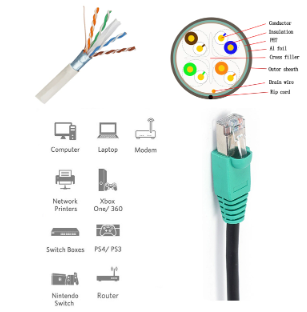Copper Data Communication: An Enduring Solution for Reliable Data Transmission
Introduction
In the realm of data communication, copper has long been a trusted medium for transmitting digital information. Despite the rise of fiber optics and wireless technologies, copper data communication continues to play a significant role in various applications. In this blog post, we will explore the history, characteristics, advantages, and limitations of copper data communication. We will also discuss its applications in modern technology, the challenges it faces, and the ongoing relevance of copper in the evolving landscape of data transmission.

- The Evolution of Copper Data Communication
Copper has been utilized for data communication since the early days of telegraphy and early telephone systems. It has evolved alongside technological advancements to support higher data rates and more complex communication protocols. From simple analog transmission to modern digital data communication, copper has proven its versatility and adaptability.
- Characteristics of Copper Data Communication
It refers to the use of copper wires or cables to transmit digital information. Copper cables are available in various forms, such as twisted pairs, coaxial cables, and Ethernet cables. These cables are designed to carry electrical signals, which represent the binary data.
Copper data communication offers several key characteristics:
a. Conductivity: Copper is an excellent conductor of electricity, allowing for efficient data transmission over relatively short distances. It ensures reliable signal integrity and minimizes loss during transmission.
b. Compatibility: Copper infrastructure is compatible with a wide range of devices, making it a versatile solution for data communication. It supports various communication protocols, including Ethernet, DSL, and analog modems.
c. Affordability: Copper cables are generally more cost-effective compared to fiber optics and other high-speed transmission technologies. The widespread availability and mature manufacturing processes contribute to their affordability.
d. Flexibility: Copper cables are flexible and easy to install, making them suitable for different applications and environments. They can be easily routed through buildings, twisted into pairs for noise reduction, and terminated with common connectors.
- Advantages :
This offers several advantages that contribute to its continued use:
a. Wide Availability: Copper infrastructure is already in place in many regions, making it readily accessible for data communication. This existing infrastructure allows for seamless integration and expansion of networks without significant additional investments.
b. Reliability: Copper cables are known for their robustness and reliability. They can withstand harsh environmental conditions, making them suitable for both indoor and outdoor installations. It is less susceptible to interference from external sources, ensuring stable and consistent data transmission.
c. Cost-Effectiveness: Copper cables are generally more affordable compared to fiber optics, making them an attractive solution for small to medium-sized businesses and residential applications. The lower installation and maintenance costs of copper infrastructure make it a cost-effective choice for many organizations.
d. Compatibility: It is compatible with a wide range of devices and equipment. It can seamlessly connect to computers, routers, switches, and other networking devices. This compatibility allows for easy integration with existing systems and simplifies network upgrades.
- Limitations and Challenges
While copper data communication has its advantages, it also faces certain limitations and challenges:
a. Bandwidth Limitations: Copper has inherent limitations in terms of the amount of data it can transmit compared to fiber optics. As data rates increase, copper’s ability to carry high-bandwidth signals over long distances becomes limited.
b. Distance Limitations: Copper cables experience signal degradation as data travels over longer distances. The quality of the signal diminishes, resulting in reduced data rates and potential errors. This limitation affects applications that require long-distance data transmission.
c. Interference and Crosstalk: Copper cables are susceptible to electromagnetic interference (EMI) and crosstalk from neighboring cables. These factors can introduce noise and degrade the quality of the transmitted signals, impacting data integrity and reliability.
d. Upgrades and Future-Proofing: As data demands continue to grow, copper infrastructure may require upgrades to support higher data rates. These upgrades can involve replacing or improving existing cables, connectors, and network equipment. Future-proofing copper data communication can be challenging due to its inherent limitations compared to fiber optics.
- The Ongoing Relevance of Copper Data Communication
Despite the emergence of fiber optics and wireless technologies, It remains relevant in several applications:
a. Local Area Networks (LANs): Copper Ethernet cables, such as Category 5e and Category 6, are widely used for LAN connections in homes, offices, and data centers. They provide reliable and cost-effective solutions for connecting devices within a limited area.
b. Telephone Networks: Copper infrastructure continues to support traditional voice communication services. Many telephone networks utilize copper lines to provide landline services to residential and business customers.
c. Last-Mile Connectivity: Copper lines are often used for the last-mile connection between service providers and end-users. In areas where fiber optics are not yet widely available,copper-based technologies like Digital Subscriber Line (DSL) provide reliable internet access.
d. Legacy Systems: Copper data communication is still necessary to support legacy systems that rely on analog or low-speed digital signals. Retrofitting these systems with fiber optics may be impractical or cost-prohibitive.
- Conclusion
Copper data communication has a rich history and continues to be a reliable and cost-effective solution for transmitting digital information. Its wide availability, compatibility, and affordability make it a practical choice for various applications, especially in situations where fiber optics are not yet feasible or cost-effective. While it has limitations in terms of bandwidth and distance, it remains relevant in local area networks, telephone networks, last-mile connectivity, and supporting legacy systems. As technology continues to evolve, the telecommunications industry will undoubtedly witness a shift towards faster and higher-capacity solutions like fiber optics. However, it is important to acknowledge the enduring role that copper plays in data communication, providing reliable connectivity and bridging the digital divide in areas where other technologies are not yet accessible.
